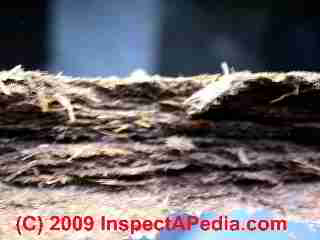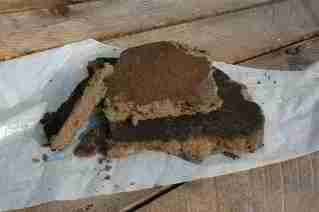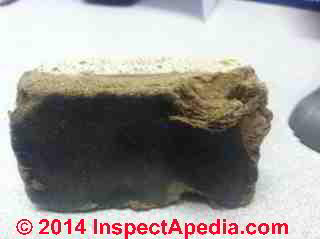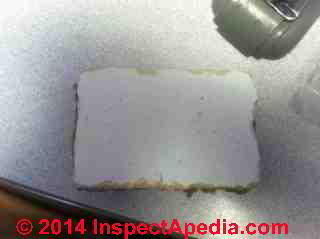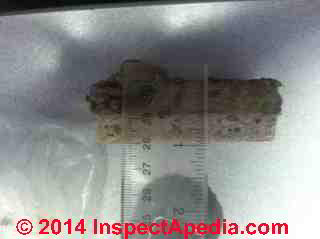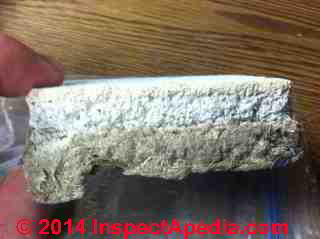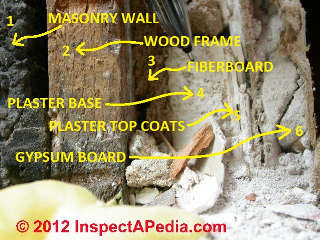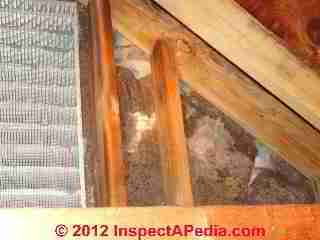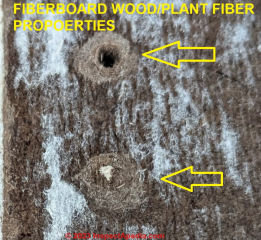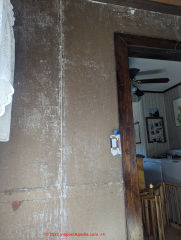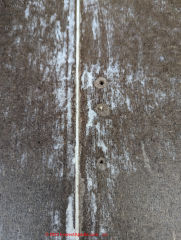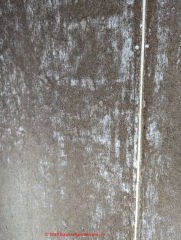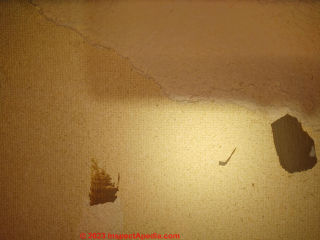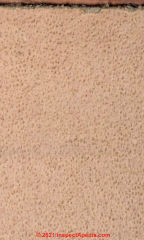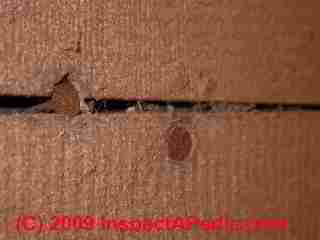 Unmarked Fiberboard Identification
Unmarked Fiberboard Identification
Building Wall & Roof Sheathing, Insulating Board Identification
- POST a QUESTION or COMMENT about fiberboard building sheathing: how to identify fiberboard products, fiberboard uses, fiberboard, Celotex, Homasote, Insulite & other brands, fiberboard ingredients, does fiberboard contain asbestos?
Un-marked or Un-labeled fiberboard insulating sheathing identification advice:
Here we help identify and give information about the manufacture, ingredients & use of various fiberboard insulating sheathing products when there is no obvious stamp or brand name on the product.
In additional photos and article links we also explain how to recognize/identify Celotex®, Homasote®, Masonite® Nu-Wood® and other insulating fiberboard building sheathing products used as exterior wall sheathing and as interior wall & ceiling surfaces.
In this article series we provide fiberboard product names and we describe the components, properties, and applications of various fiberboard, hardboard, and insulating board or sound deadening board products. We also answer questions such as do Celotex or Homasote or other fiberboard and insulating board products contain asbestos? fiberboard water resistance, fiberboard recycling.
InspectAPedia tolerates no conflicts of interest. We have no relationship with advertisers, products, or services discussed at this website.
How to Identify Unlabeled Fiberboard Products
At the top of this page is an insulating fiberboard product that is not the Homasote™ brand.
Homasote Chairman and CEO Warren L. Flicker has generously added these comments that assist in distinguishing among fiberboard product brands and manufacturers:
The pictures at left and below show a brown side and a black side [and show layering when broken to expose the material in cross-section]. They are not Homasote®.
Our photos (below) show close ups of fiberboard insulating building sheathing board products that are not Homasote™ brand, including a torn cross section showing the layered fibrous character and the distinctly-brown surface of this material.
Our photo below shows pieces of fiberboard roof insulating fiberboard removed from a building by reader/contributor Doug Leen.
The varying colors of the two sides of the material are visible - the darker side of this insulating board may have been that exposed to light and air during its life in the building.
The material looks like a Celotex product.
According to Thermafiber® it is not their product.
According to Homasote® this is not their product.
Generic Fiberboard Names: Celotex, Homasote, Beaverboard
Synonyms for fiberboard along with related names that get mixed-up with low-density or soft cellulose based insulating board products include the following:
- aglomerado de madeira (Port.)
- brown board or Brownboard,
- caneboard - see CANEBOARD PANELS
- carton-fibre (Fr.)
- carton fort (Fr.)
- Celotex - see CELOTEX HISTORY & PRODUCTS
- composition board
- fibre-board (Br.)
- fibreboard (Br.)
- fiber board
- fiberboard - see FIBERBOARD SHEATHING
- HDF or high density fiberboard or "Masonite" - see HDF HIGH DENSITY FIBERBOARD Products
- hardboard - see HARDBOARD SIDING & also see FIBERBOARD ROOFING & FIBER-WOOD ROOFING
- Homasote - see HOMASOTE HISTORY & PRODUCTS
- insulating board
- Insulite - IDENTIFY Insulite
- low-density fiberboard (LDF) - see LOW DENSITY FIBERBOARD
- medium-density fiberboard (MDF) - see MDF Medium-Density Fiberboard
- particle board
- wallboard
The producers of fiberboard can be expected to take polite exception to the mis-naming of fiberboard interior or exterior sheathing or wall or ceiling panels that mix-up company names and product names.
Some but not all fiberboard products by different companies have differences in appearance, color, texture, or stampings and markings that they should not be confused. We will give those details later in this article series.
But it's certainly the case that some fiberboard or insulating board sheathing products bear no markings and little unique identifying texture. In those cases I'd prefer to simply call it "fiberboard sheathing" or "fiberboard panels" or "insulating board".
If we're trying to identify the material, let's not call generic fiberboard "Celotex" or "Homasote" or "Beaverboard" because probably it's not one of those specific companies' products.
Homasote Co., the oldest manufacturer of building products from recycled materials in the United States, was founded by Eugenius Harvey Outerbridge as Agasote Millboard Company, and has been producing this material since 1909. In 1936 the company changed its name to its best known product, Homasote.
Insulating building sheathing made by Homasote® is produced by the Homasote Company, a manufacturer in the U.S. in New Jersey, and similar fiber sheathing products have been used both as a sound barrier and for exterior sheathing on buildings.
Originally, Homasote® produced sanded "agasote" sheets used in the roofs of passenger railroad cars, moving, in 1915, to automobile roofs, and in 1916 to construction products. Homasote was widely used for military barracks in both WWI and WWII and is still promoted for sound resistant sheathing and other applications.
Celotex®, Homasote®, Thermafiber®, and similar insulating building sheathing board products are still sold as a lower cost alternative to plywood or OSB for building sheathing. The product is used as structural paneling, insulation, concrete pouring forms, and expansion joints.
This fiberboard sheathing product is used as structural paneling, insulation, concrete pouring forms, and expansion joints.
Reader Question: From a 1944 Minnesota home, can you tell me what this soft brown fiberboard material is?
Hi, I was wondering if you would be able to identify the following pictures. They are receptacles cut outs from an interior wall. House was built in 1944, in the state of Minnesota. It looks like a fiberboard material is the backer. But not really sure what finished side is.
It's almost like a cement board that's glued directly to the fiberboard. It's very strong. Anyway any info you could give me would be greatly appreciated. - M.S.T. 3/26/14
Reply:
Your photos look like a wood product fiberboard sheet that has been coated or painted presumably on the room side. Depending on the age you should be alert for possible lead paint hazards.
This material was used both as an insulating sheathing on building exteriors (under siding) and as a finish interior wall and ceiling board such as in the case you describe.
Take a look through the fiberboard examples above for some close comparisons to make an educated guess about the exact material. To be more precise we'd need to make a lab comparison with known samples in our library.
The gray backer behind the plaster shown in our second photo, if it is a soft fiberboard, is probably Homasote®. If the gray backer is cementious it's probably a plasterboard used as a board-lath.
Reader follow-up:
I was wondering if you could identify the concrete/slash stucco covering that is glued to the fiberboard. It is 1/2" thick and is uniform in thickness. It has many small rocks and sand mixed in it. The top 1/8" of it is different color than the bottom. Once again any info you can give me would be appreciated.
Reply:
We're looking at fiberboard backer used as a base on which a plaster coating was applied. We see the rough coat - the thicker white layer - also known as a "scratch coat" and then the thinner tan layer is most likely the smooth coat or top coat of plaster, perhaps on which there was also paint finally applied.
I've encountered this construction before in some older homes from the 1920s to late 40's in the U.S. and I imagine it was used elsewhere.
Watch out: some plaster from that era contained asbestos.
At CEILINGS & WALLS, PLASTER TYPES you can see a photo similar to yours but as your image is better I'll want to add it there.
At above left we see my photo from that article. It shows that the very first or original layer of wall was fiberboard over which plaster was applied. My pen point is indicating the plaster. The brown fiberboard backer is to the left of the pen.
Question: can we identify this fiberboard sheathing from a 1975 home in New England?
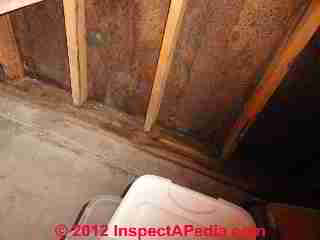
I am trying to identify this wall sheathing material. It appears to be an asphalt impregnated fiberboard sheathing, but does not have a brand name. This photo was in the attic at the gable end behind the chimney. The entire garage also uses this product.
The home is a two story colonial build in 1975 in New England. Thanks for any help. - Mike - home inspector - 11/09/2012
Reply:
Mike, I agree that in your photos the sheathing material looks like fiberboard sheathing, and that branding can be difficult. Take a look at our article [above] on this material for some colors and other properties.
Sorry I can't say more from just photos. But in any case fiberboard sheathing was not impregnated with asphalt but rather typically with a wax for water resistance.
Some brands of fiberboard using a dark surface coating might fool you into thinking it was asphalt, but as you'll read in the common ingredients listed above, that's not so likely.
Because the properties of these various products are similar across brands (varying in density, coatings, water resistance, nail-holding power) I'm not sure we need to know the brand to evaluate the material shown in your photos - it's water damaged, meaning that we ought to be looking for related insect damage or rot or mold on nearby building materials, and we ought to be finding and fixing the leaks.
Thanks for the excellent photos - I'll post them here at InspectApedia to permit other professionals to comment.
Reader Follow-Up:
My client was very concerned about the water damaged materials. It appears that all of the viewable sheathing was in poor condition.
There was evidence of a prior WDI treatment on the front porch where I noticed a series of drilled holes through the concrete slab. The basement is finished limiting the scope of my home inspection. - M.Q.
Reply:
Thanks for the follow-up M.
Indeed, to my surprise (as the materials were originally treated and sometimes even smelled waxy or like petroleum products) I've on occasion found insect infestation right in the fiberboard sheathing.
As you are a professional home inspector I imagine that we'd probably agree that the underlying questions are:
- Do we need to address an active insect infestation
- If there was prior treatment, was it performed properly and safely
- Is there accompanying structural damage that needs repair
- Is the sheathing serving as a nail base for siding - if so and if it is extensively damaged such that removal and replacement of siding become necessary, significant costs would be involved.
- Have the causing leaks been fixed
It is my OPINION that if there is no active infestation and no actionable structural damage, (you'd have pointed out obvious movement and warned about possible hidden damage not discoverable without demolition), no ongoing leaks, and if siding is nailed to studs not sheathing, then if there is no longer ongoing leakage, the impact of leaving the materials in place is minimal.
The tough question is whether there is enough visible damage (or discovered damage by perhaps some gentle invasive investigation) to justify more extensive exploration for significant problems.
Often, such as in some mold or IAQ investigations, we reach agreement with the client to stop cutting into the building by noting the absence of visible evidence of structural movement, damage, or infestation sufficient to justify, in our joint opinion, further invasive inspection.
That does not promise that there are no hidden concerns, but rather that we can't together find reason to justify continued hacking apart of the building.
If the client wants further investigation, I'd pick the "most suspect" areas for hidden damage and start there, reasoning that if the most-suspect areas don't reveal actionable trouble, it would be reasonable to quit exploring.
Reader Comments, Questions & Answers About The Article Above
Below you will find questions and answers previously posted on this page at its page bottom reader comment box.
Reader Q&A - also see RECOMMENDED ARTICLES & FAQs
On 2023-04-21 by InspectApedia Publisher (mod) - woody plant fibers indicate fiberboard products
@JK Re-posted by Moderator,
Zooming in on this photo where there are a couple of holes left by removal of a screw or nail, we see what looks like gray-brown plant or wood fibers - thi sis most likely one of the fiberboard products described above on this page.
On 2023-04-21 by JK Re-posted by Moderator (mod)
From private email
10 April 2023
Anonymous asked
Hello! I've started to remove wallpaper in boyfriends older home. I'm new to DIY work, but I can't say I've ever seen a wall like this.
I want to make sure it's safe for me to continue to work on it or if I should be gearing up a bit more. Any help identifying would be appreciated. Thank you!!
The white in the board is wallpaper glue residue.
Photo 2
Photo 3
On 2021-11-09 by InspectApedia Com Moderator (mod) - asbestos would not have been used as fiberboard binder/adhesive
@Bob Ruteledge,
(and your alterego @john marker)
Please find your question and comment and a detailed reply now organized at
CLASSES & TYPES of FIBERBOARD PRODUCTS
Asbestos was never added as a bonding agent to fiberboard because it is not an adhesive.
But asbestos was used in both fiber and shorts or "powder" form as a strengthener and filler in some products such as floor tiles and some sheet flooring backers, and of course it was widely used in fire-resistant materials and products.
On 2021-11-07 by Bob Ruteledge
Re-posting with vetted web link to a source at the publisher springer:
Bob Ruteledge said:
Perhaps, the best factor for classifying fiberboard is the density. This is internationally recognized. There is a rather simple difference between pressed and
not pressed sheets hut the range of qualities is wide and there is an overlapping.
Another point which should be taken into consideration is the fact that wood
fibers are blended occasionally with mineral fibers (such as asbestos), plastics
and with other chemical additives.
Some half-hard fiberboard contain no less than 20% of thermoplastic bonding agents.
I found this:
- Stillmann F.F.P., Kuenzi E.W., Stamm A.J. (1975) Fiberboard. In: Principles of Wood Science and Technology. Springer, Berlin, Heidelberg. doi.org/10.1007/978-3-642-87931-9_6
Abstract
There are various types of fiberboard, and unfortunately the terminology is not yet internationally standardized. Neverthelesss, one fundamental definition generally is recognized
(FAO, 1958/1959, p. 4):
“Fiberboard is a board generic term encompassing sheet materials of widely varying densities manufactured from refined or partially refined wood fibres or other vegetable fibres.
Bonding agents and other materials may be incorporated in the manufacture of the board to increase strength, resistance to moisture, fire or decay or to improve some other property.”
In the technical sense the ISO-definition is more precise:
“Sheet material generally exceeding 1.5 mm in thickness, manufactured from ligno-cellulosic fibers with the primary bond from the felting of the fibers and their inherent adhesive properties.
Bonding materials and/or additives may be added”.
Excerpt from p. 1
FAO, OEEC and ISO used formally various definitions but the differences between them are without practical importance. The classification of fiberboard into types is based on:
a) Type of raw material and method of fiber production;
b) Method of sheet formation;
c) Density of product (kg/m3 or g/cm3 or Ib./cu. ft.);
d) Kind and place of application.
Perhaps, the best factor for classifying fiberboard is the density. This is internationally recognized. There is a rather simple difference between pressed and not pressed sheets hut the range of qualities is wide and there is an overlapping.
Another point which should be taken into consideration is the fact that wood fibers are blended occassionally with mineral fibers (such as asbestos), plastics and with other chemical additives.
Some half-hard fiberboard contain no less than 20% of thermoplastic bonding agents. The general term "fiberboard" is not only adopted for use in the publications of FAO and ECE, but is generally understood in the literature and in the industry.
FAO (1958/1959) gives a survey on the nomenclature. Fiberboard is manmactured from separated fibers or bundles of them. This is a fundamental difference between fiberboard and particleboard.
Fiberboard is produced by interfelting of fibers in such a way as to produce a mat or sheet. The properties of the mat depend on the characteristic natural bonding of fibers between themselves.
Chemicals may be added during manmacture with the aim to improve the cohesion and the water resistance. Typical of fiberboard is the wide range in densities between 0.02 and about 1.45 g/cm3 (,,-,1.25 and 901b/ cu. ft.).
Fiberboard are used mainly as panels for insulation and as covering materials in buildings and constructions, where flat sheets are necessary and a moderate strength is needed. Fiberboard are also used as parts in doors, cabinets, cupboards, furniture, etc.
6.1 History and Development
The origin of wood fiberboard goes back to Japan where as early as in the 6th century B. O. heavy papers were used for the construction of walls for small houses. In Europe a patent was granted to the British inventor Clay in 1772 for the application of "papier mache" (Neu88er, 1957) not only for use in dwellings, furniture, doors, but also for carriages.
The idea of using the new material for big stüf building elements was evident. Since the middle of the 19th century, the proposals for use of fiberboards have greatly increased. More than 200 patents were issued in this field between 1858 and 1928 (Ro88mann, 1928), more than 600 patents until1957 (Neu88er, 1957).
In spite of these early developments the actual fiberboard industry started near the beginning of the 20th century in England and in the U.S.A. The development up to 1926 was rather sporadic and without a remarkable increase in capacity.
The historical development of fiberboard industry is shown condensed in Tables 6.2 and 6.3. There may be some uncertainties or even some gaps in the summaries, but in general they show the sequence of the development.
---
So does this mean that old fiberboard material found in walls and ceilings could have asbestos mixed in it?
On 2021-03-25 by danjoefriedman (mod) - pre grooved fiberboard interior wall panel
@Wall fiberboard no marking #2,
Your photos show a pre grooved fiberboard interior wall panel that provided both some insulating value and a finished surface. More than one brand of these products was produced.
Beaverboard is an example.
On 2021-03-25 by Wall fiberboard no marking, 14-inch spaced grooved joints of a 1950s home
No marking on back. One photo is showing the design 14" width bevels on each side then an additional inch each side for tongue and groove joint.
Any idea brand? On every interior wall in my house built in 1950.
Back side is tan
On 2021-01-28 - by (mod) -
Agreed. And I'm glad to be of whatever help we can. There is in fact a sickening amount of information about fiberboard, asbestos, and risk assessments in the article series found here.
On 2021-01-27 by Ellen
Thanks again. I read through that article, very helpful. Understood as far as risk assessment goes, and I appreciate your input. It’s helpful to have some basic info.
On 2021-01-27 - by (mod) -
Ellen:
Yes BUT keep in mind that NOBODY can make a true, reliable assessment of risks to you or others in your home based simply on a brief e-text or a photo.
Also see the warnings at
OTHER PEOPLE's MONEY
On 2021-01-26 by Ellen
Thank you for the speedy reply. So if I understand, even though it’s been broken at some point, if I leave it alone it shouldn’t cause any issues?
Undisturbed an edge of asbestos cement board nor any other "board" or sheathing product isn't likely to produce a detectable airborne asbestos hazard.
Frankly I can't make out much at all in your photo: I don't know if we're seeing gypsum board or something else.
On 2021-01-26 by Ellen - is the exposed edge this "board" product dangerous?
Thank you for your previous reply and help. I think I found where that random piece of board came from. It appears to have been broken off a sheet that is installed in between the first and second floor of my home, in the general vicinity above my downstairs fireplace. I’m willing to bet given that, that there is some asbestos content given its fire resistance.
I am not sure how long it has been in the state.
The piece could’ve been broken off anywhere as recently as five years ago, or could’ve happened decades ago before we owned the home. You mentioned before that it was cementious and therefore non friable, which is reassuring.
My question is, is there any danger or hazard posed by the broken edge in the attached photo? I will note that this is inside a wall cavity that is accessible via a non-airtight door in the wall (which opens into living space)
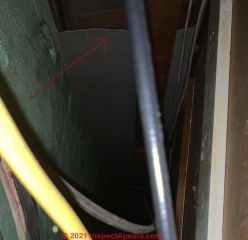
On 2021-01-02 - by (mod) -
sure
On 2021-01-02 by Ellen
Thank you! It’s one small piece that isn’t attached to anything, would it make sense to mist mist it and seal it in a contractor bag?
On 2021-01-02 by mod) - cement asbestos board identification
That looks like cement board, possibly containing asbestos; cementious, not friable, don't make a dusty mess.
See details at CEMENT ASBESTOS SHEET PRODUCTS
On 2021-01-02 by Ellen - identify this board material in a 1959 home
Found this piece of some sort of board leaning up against the back side of my chimney (in the unfinished area near my electric panel. No idea how long it’s been there, I don’t look here often.
House was built in 1959. Any help identifying it would be much appreciated. It looks gray in the photos but in reality seems a bit more tan.
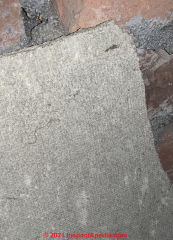
On 2019-11-28 by (mod)
Chris that looks like a suspended ceiling tile;
Enlarging it I see gray-white fibrous material - possibly containing asbestos but of course nobody can be certain without more information: a product brand and model stamping, the age of the material, its country of location, or a lab test for asbestos.
On 2019-11-28 by Chris
Do you know what type building material this is
...
Continue reading at FIBERBOARD SHEATHING IDENTIFICATION or select a topic from the closely-related articles below, or see the complete ARTICLE INDEX.
Or see these
Recommended Articles
- DRYWALL, FIBERBOARD, PLASTER INTERIORS
- HARDBOARD Masonite™-like INGREDIENTS
- SHEATHING, FIBERBOARD - home
- CANEBOARD PANELS
- CARDBOARD CORRUGATED FIBERBOARD
- CELOTEX HISTORY & PRODUCTS
- DEFINITION of FIBERBOARD SHEATHING
- FIBERBOARD CEILING & WALL COVERINGS
- FIBERBOARD MANUFACTURERS & BRAND NAMES
- FIBERBOARD PANEL REPAIR
- FIBERBOARD PLASTER BASE SYSTEMS
- FIBERBOARD ROOF SHEATHING
- FIBERBOARD SHEATHED WALL BRACING
- FIBERBOARD SHEATHING ASBESTOS CONTENT
- FIBERBOARD SHEATHING INGREDIENTS
- FIBERBOARD SHEATHING FIRE RATINGS
- FIBERBOARD SHEATHING IDENTIFICATION
- CLASSES & TYPES of FIBERBOARD PRODUCTS
- EXTERIOR vs INTERIOR FIBERBOARD TYPES
- IDENTIFY Allied Chemical / Barrett® R-Brace Insulating Board & Fiberboard
- IDENTIFY BEAVERBOARD / BUFFALO BOARD
- IDENIFY CANEBOARD PANEL
- IDENTIFY Celotex® Insulating Board and Fiberboard Products
- IDENTIFY Eastman sheathing board
- IDENTIFY Homasote® Brand Fiberboard
- IDENTIFY Insulite, or Graylite cellulose fiber board product useful for plasterboard
- HARDBOARD MASONITE™ & OTHER BRANDS
- IDENTIFY National Gypsum Gold Bond® Brand Insulating Board
- IDENTIFY NU-WOOD PANELS
- UNIDENTIFIED FIBERBOARD PRODUCTS
- UPSON BOARD
- WOOD FIBRE INSULATING PANELS
- FIBERBOARD SHEATHING INSECT DAMAGE
- FIBERBOARD SHEATHING MOLD CONTAMINATION
- FIBERBOARD SHEATHING MSDS
- FIBERBOARD ROOFING & FIBER-WOOD ROOFING
- FIBERBOARD PROTECT from WATER
- FIBERBOARD SOUND INSULATION
- HARDBOARD MASONITE™ & OTHER BRANDS
- HARDBOARD Masonite™-like INGREDIENTS
- HARDBOARD & MASONITE USED in WORKS OF ART
- HISTORY of FIBERBOARD INSULATING SHEATHING
- HOMASOTE HISTORY & PRODUCTS
- SHEATHING, FIBERBOARD ASBESTOS CONTENT
- SHEATHING FIBERBOARD CONSTRUCTION
- SIDING HARDBOARD IDENTIFICATION & CLAIMS
- SUNDEALA BOARD COMPOSITION & HISTORY
- SYNONYMS for FIBERBOARD SHEATHING
- SHEATHING, EXTERIOR PRODUCT INDEX
- SHEATHING FIBERBOARD CONSTRUCTION
Suggested citation for this web page
UNIDENTIFIED FIBERBOARD PRODUCTS at InspectApedia.com - online encyclopedia of building & environmental inspection, testing, diagnosis, repair, & problem prevention advice.
Or see this
INDEX to RELATED ARTICLES: ARTICLE INDEX to BUILDING STRUCTURES
Or use the SEARCH BOX found below to Ask a Question or Search InspectApedia
Or see
INDEX to RELATED ARTICLES: ARTICLE INDEX to BUILDING INTERIORS
Or use the SEARCH BOX found below to Ask a Question or Search InspectApedia
Ask a Question or Search InspectApedia
Try the search box just below, or if you prefer, post a question or comment in the Comments box below and we will respond promptly.
Search the InspectApedia website
Note: appearance of your Comment below may be delayed: if your comment contains an image, photograph, web link, or text that looks to the software as if it might be a web link, your posting will appear after it has been approved by a moderator. Apologies for the delay.
Only one image can be added per comment but you can post as many comments, and therefore images, as you like.
You will not receive a notification when a response to your question has been posted.
Please bookmark this page to make it easy for you to check back for our response.
Our Comment Box is provided by Countable Web Productions countable.ca
Citations & References
In addition to any citations in the article above, a full list is available on request.
- Jester, Thomas C., ed. Twentieth-century building materials: History and conservation. Getty Publications, 2014.
- Wood Conversion Company, "NU-WOOD INTERIORS FOR EVERY WALL AND CEILING", [PDF] Wood Conversion Company, St. Paul Minnesota, (u1936), retrieved 2015/12/04, original source: https://archive.org/stream/ Nu-woodInteriorsForEveryWallAndCeiling/ Nu-woodInteriorsForEveryWallAndCeiling_djvu.txt,
- Wilson, Richa, Kathleen Snodgrass, "Early 20th-Century Building Materials: Fiberboard and Plywood", [PDF] (2007) United States Department of Agriculture, Forest Service, Technology & Development Program, 073-2308-MTDC, retrieved 2017/07/29, original source: https://www.fs.fed.us/t-d/pubs/htmlpubs/htm07732308/
- [1] Homasote® Company, 932 Lower Ferry Road, West Trenton, NJ 08628-0240 Tel: 800-257-9491 Ext 1332, or from outside the U.S. call 609-883-3300. Website: http://www.homasote.com/ , Email: Sales@homasote.com.
- Thanks to Homasote CEO Warren Flicker for technical review and comment on this article.
- [2] Celotex Corporation, PO Box 31602, Tampa FL 33631, with offices in Atlanta, Chicago, Cincinnati, Dallas, Oakland and Philadelphia, and plants in six U.S. States is headquartered in Tampa, FL. Celotex is a national manufacturer of residential and commercial building materials. Website: www.celotex.com Tel: 800-CELOTEX
"Insulation Selector Guide", Celotex Corporation, web search 6/29/12, original source: http://www.silvercote.com/PDF/ThermaxInsulSelectorGuide.pdf, [copy on file as CelotexThermaxInsulSelectorGuide.pdf ]
"Celotex Blue Ridge Fiberboard", SturdyBrace®, produced by Blue Ridge Fiberboard Inc., 250 Celotex Dr., Danville VA 24541, product literature, web search 6/29/2012, original source: blueridgefiberboard.com/pages/sturdybrace.php, [Copy on file as Celotex_BlueRidge_SturdyBrace.pdf].
MSDS: original source: blueridgefiberboard.com/pages/sturdybrace/pdfs/SturdyBrace-msds-br.pdf
"Guide Specifications: SturdyBrace® Structural Fiberboard Wall Sheathing", 6/29/12, original source: blueridgefiberboard.com/pages/sturdybrace.php [Copy on file as SturdyBrace-guidespecs.pdf] - [3] Douglas Leen, Petersburg AK 99833, contributed the photograph of insulating board scraps from roof insulation removed from a building. Dr. Leen provides such a wide range of services, collectables, and historical information about the Northwest that a succinct description is difficult: flying dentist goes anywhere, antique forestry posters, historic campers, the tugboat Katahdin, in Alaska, Washington, and Wyoming. Mr. Leen can be contacted at mail@dougleen.com or at 907-518-0335
- [4] Georgia Pacific: information about DensGlas gypsum board building sheathing can be found at the company's website at gp.com/build/product.aspx?pid=4674
- [5] "Roof Shingle Tear-Off Procedure for Homasote Products", PDF document, Homasote Co., 932 Lower Ferry Road, West Trenton, New Jersey 08628-024, U.S.A. 800-257-9491 website: at www.homasote.com
- [6] Thermafiber, Inc., (now a division of Owens Corning®) at Thermafiber, Inc., 3711 Mill Street, Wabash, IN 46992, Tel: 888-834-2371 (U.S. & Canada) - 260-563-2111 Website: www.thermafiber.com or Thermafiber technical services at 888-834-2371 (U.S. & Canada) ; Phone: 260-569-0801, Fax: 260-563-8979 or Email: technicalservice@owenscorning.com
- [7] Weaver: Beaver Board and Upson Board: Beaver Board and Upson Board: History and Conservation of Early Wallboard, Shelby Weaver, APT Bulletin, Vol. 28, No. 2/3 (1997), pp. 71-78, Association for Preservation Technology International (APT), available online at JSTOR.
- [8] Pittsburgh Press, "Yesterday - in costly homes alone, Today even the simplest home can have this hidden comfort", The Pittsburgh Press, 19 April 1925, classified ads section. Web search 6/22/12, [Copy on file as Celotex_Ad_023_PP.jpg and more]
- [9] pending research
- [10]
Patents pertaining to building insulation & insulating board, Celotex & Insulating Board type products
- "Sound absorbing board for walls and ceilings", Patent No. 1,554,180, issued to W.S. Trader, September 15,1925, first disclosed a wallboard constructed from "Celotex", a felted mass of strong bagasse fibers, so compacted as to be capable of use as an artificial lumber in that it can be sawed and nailed, and has sufficient strength in many cases to be substituted for lumber. That same patent mentions "Insulite", a building board made from wood pulp tailings and which likewise has a porous fibrous body portion and which is possessed of considerable strength so that the same can be nailed, etc. Celotex was preferred as an insulating material because its internal cells produce a sound-deadening insulating effect.
- "Method and apparatus for drying moving material", Treadway B. Munroe et als, assigned to Dahlberg & Co., U.S. Patent No. 1,598,980, 7 September 1926, described a method and apparatus for drying sheets of artificial heat insulating lumber, known on the market as Celotex, improving the original process.
- "Reenforced composition board", Treadway B. Munroe et als, U.S. Patent No. 1,578,344, 30 March 1926
- "Insulating Structural Board", U.S. Patent 2,159,300, Armen H. Tashjian et als, assigned to William B. Miller, Lakewood OH, 23 May 1939, describes insulating structural boards of laminated construction for use as roof or floor slabs, and refers to "Standard insulating fiber boards, such as "Celotex", "Masonite", "Insulite", etc. that had excellent insulating properties but have relatively slight structural strength in flexure or bending under load, hence are not and cannot be used as structural slabs for load sustaining purposes, as roof or floor slabs, for example. [Adding structural strength ran into the problem of reducing the insulating value of the product.]
- "Sound-absorbing chamber", Treadway B. Munroe et als, U.S. Patent No. 1,705,778, 19 March 1929 (using Celotex to construct a sound deadening chamber.
- "Method of and apparatus for drying moving material", U.S. Patent 2,376,612, Carl G. Muench, New Orleans, assigned to Celotex Corporation, described a method and apparatus for drying sheets of artificial heat insulating lumber, preferably formed by the felting of bagasse fiber along with other materials necessary to make a satisfactory structural fiber board. 22 May 1945
- "Sound-absorbing board for walls and ceilings," U.S. Patent 1,554,180, Sept. 15, 1925, Wilber S. Trader, assignor to Dahlberg & Company, Chicago IL. described an interior-use sound insulating product.
- [11] "Insulite Co. v. Reserve Supply Co.," 60F.2d 433 (1932), Circuit Court of Appeals, Eighth Circuit, July 26, 1932. Web Search t/23/12. Quoting:
Rabbeted joints in material to which plaster or other material is applied are found in the Jones patent, No. 886,813. In this patent the composition is made up of plaster of paris, cement, or other like substance, combined with hair, wood fiber, sawdust, wool, wood shavings, excelsior, straw, or similar substances. The length of the lath covers three joists instead of four. The boards are arranged in staggered relation to each other and the joints are shiplapped. The specification states that after the boards or blocks are placed in position they may be covered with wallpaper or other similar material, which, of course, would include plaster.- "Machine for perforating Insulite Boards", U.S. Patent No. 1,306,283, Patented 10 June 1919, John K. Shaw, inventor from Minneapolis MN, describes improvements for machines for perforating Insulite Boards.
- "Before you Build write for this mailing piece and a sample of Insulite", [advertisement], The Literary Digest, 13 September 1940.
- [13] "Separating the Fiber of Wood", A.S. Lyman, U.S. Patent No. 21,077, 3 August 1858
- [14] Standards pertaining to fiberboard insulating sheathing:
- ASTM C 208-95 (2001) – Standard Specification for Cellulosic Fiber Insulating Board. Type IV Grade 2 (Structural Wall Sheathing).
- ASTM C 846-94 (2003) – Application of Cellulosic Fiber Insulating Board for Wall Sheathing.
- ASTM D 1554 - Definitions of terms Relating to Wood Based Fiber and Particle Panel Materials.
- ASTM E-72 (1997)- Standard Method for Conducting Strength Tests of Panels for Building Construction.
- ANSI /AHA - A194.1, Cellulosic Fiberboard.
- U.S. Department of Commerce: PS57-73, Cellulosic Fiber Insulating Board
- A.F.A. (2003): Fiberboard Sheathing test results
- [15] "Properties of insulating fiberboard sheathing", Forest Products Laboratory (U.S.) Luxford, R. F. (Ronald Floyd), 1889 (1960), original report 1955, citation:hdl.handle.net/1957/2489, web search 6/29/12, original source: http://ir.library.oregonstate.edu/xmlui/handle/1957/2489
- In addition to citations & references found in this article, see the research citations given at the end of the related articles found at our suggested
CONTINUE READING or RECOMMENDED ARTICLES.
- Carson, Dunlop & Associates Ltd., 120 Carlton Street Suite 407, Toronto ON M5A 4K2. Tel: (416) 964-9415 1-800-268-7070 Email: info@carsondunlop.com. Alan Carson is a past president of ASHI, the American Society of Home Inspectors.
Thanks to Alan Carson and Bob Dunlop, for permission for InspectAPedia to use text excerpts from The HOME REFERENCE BOOK - the Encyclopedia of Homes and to use illustrations from The ILLUSTRATED HOME .
Carson Dunlop Associates provides extensive home inspection education and report writing material. In gratitude we provide links to tsome Carson Dunlop Associates products and services.



